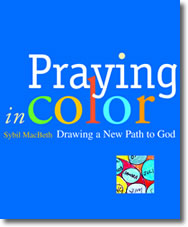Praying
in Color
A conversation with friends and authors Sybil MacBeth and
Phyllis
Tickle on a whole new way
to pray without words
download
the entire conversation <mp3>
subscribe
to explorefaith's new podcast
read
an excerpt from the book
 How do you pray when words become barriers rather than possibilities?
When thinking in sentences is too linear to express a rainbow of
emotions. During a time in her life when close friends and family
were sick and in need, Sybil MacBeth was struggling with how to
pray. Her book Praying in Color describes the prayer process
that came out of that time—a process she now uses regularly
and teaches to others in workshops.
How do you pray when words become barriers rather than possibilities?
When thinking in sentences is too linear to express a rainbow of
emotions. During a time in her life when close friends and family
were sick and in need, Sybil MacBeth was struggling with how to
pray. Her book Praying in Color describes the prayer process
that came out of that time—a process she now uses regularly
and teaches to others in workshops.
These
prayers use design and color to communicate deep feelings, rather
than relying on just the right word.
Phyllis
Tickle’s name is associated with a very different type of
prayer. She is author of the multi-volume set The
Divine Hours—manuals for praying at fixed hours throughout
the day, a practice Phyllis has observed for decades. In the conversation
that follows two good friends and dedicated “pray-ers”
talk about their different ways to pray and how each moves us closer
to the ear, and voice, of God.
Some
clips from the conversation:
MacBeth:
I am not an artist…. I can’t draw a thing, but one
of the ways I relax is by doodling, because I love color….
About five years ago, a whole bunch of my friends and family were
really
sick, and I really did not know how to pray for them…. I
just didn’t have the words…. One day I was on my porch
doodling… and I realized I didn’t have to know the
words,… the
doodling helped me focus on them and hold them in the presence
of God.
Tickle:
There are two distinct ways of praying… one of which is what
Scot McKnight calls praying with the church… as opposed
to freestyle or personal prayer... neither is intended to be
the whole
prayer experience for the Christian…. What Sybil is describing
is a method of personal prayer. What the Divine Hours…
describes is praying with the church, that is praying at fixed
times with fixed words using materials that are essentially assigned
to
that day within the liturgical year. When you do that, what you
are really doing is praying with Christians all over your time
zone
who are doing more or less the same words….
Fixed
hour is not intended to be personal in any way. It is an opportunity,
a privilege given to the creature to worship God. What Sybil’s
doing is… so far as I know, it’s the first innovative,
post-modern, truly American approach to personal prayer.
MacBeth:
The neat thing for me about
Praying in Color is that it is both a process and a product….
Sometimes I will do it for 10 minutes, sometimes for half and
hour,
but there has really been a meditation, a prayer time for me. But
then since I have done it and because I have it on paper, I carry
it with me…. Sometimes I carry it physically, sometimes because
I have the visual pictures… those images continue to pop
up in my mind during the day so I am working toward praying unceasingly
for the people who are in my pictures.
Tickle:
We Protestants think of prayers as involving words, and it doesn’t
have to. And you don’t have to be some kind of Eastern guru
to be non-verbal.
The
whole business of entering prayer without the vehicle of words is
very important, for it allows the spirit to flow freely with the
spirit of God, and does not have to articulate what is happening
until one comes out from prayer.
I
think prayer is a place…Prayer and the physical world
are in many ways two parallel existences, two parallel spaces, one
geographic and one not. …Especially the non-locative
world does not have to be articulated to be important to one’s
spiritual life. The color not only allows concentration… color
is a vocabulary.
MacBeth:
The other thing I think about not bringing your words into there
is that it really does create a place where you can then actually
listen.
download
the entire conversation <mp3>
subscribe
to explorefaith's new podcast
read
an excerpt from the book
Sybil
MacBeth is a mathematics instructor, dancer, and the spouse of an
Episcopal priest in Memphis, Tennessee. She has been leading workshops
across the U.S. using Praying in Color for two years, and
will soon be teaching others to do the same.

To purchase a copy of PRAYING
IN COLOR, visit amazon.com. This link is provided as a service
to explorefaith visitors and registered
users.
|




